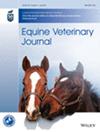Systemic calcinosis in horses: Pathological and genetic aspects
Abstract
Background
In horses, systemic calcinosis is a rare syndrome characterised by muscle lesion associated with the mineralisation of large muscle groups or other organs, in the absence of an alternative cause for the calcification, such as toxic, enzootic or metabolic. Molecular and histopathological aspects of the disease are still poorly elucidated.
Objectives
To describe the epidemiological, pathological and molecular aspects of systemic calcinosis in a convenience sample of six horses submitted to necropsy in the Southern and Midwestern regions of Brazil.
Study design
Retrospective exploratory study.
Methods
Post-mortem necropsy records of six horses with a cause of death compatible with systemic calcinosis, were reviewed followed by histopathology, immunohistochemistry, microbiology and molecular investigation.
Results
The affected horses were all Quarter Horses with a mean age of 16.8 months, and an average disease course of 15.5 days. Muscle necrosis and mononuclear infiltration were observed in all animals in association with mineral deposition variably affecting the muscle tissue and/or other organs such as heart, lung and kidney. All tested animals (5/6) showed positive PCR results for the E321G MYH1 gene variant, which encodes the heavy chain of fast-contracting skeletal muscle myosin and is associated with myopathy. Three horses demonstrated positive immunostaining for Streptococcus equi, which is a known trigger for immune responses.
Main limitations
The study was limited by the small sample size, molecular evaluation was not completed in one animal due to technical limitations, lack of pre-mortem evaluation of calcium metabolism and lack of accurate descriptions in the necropsy reports of involvement of each muscle individually.
Conclusions
In horses, systemic calcinosis syndrome causes immune-mediated muscle lesions in association with calcification of organs and tissues, varying greatly among animals. The E321G MYH1 variant was present in all horses tested for the variant and could be involved in the pathophysiology of systemic calcinosis.

 求助内容:
求助内容: 应助结果提醒方式:
应助结果提醒方式:


